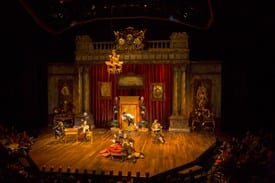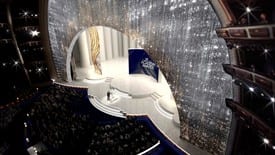His World’s a Stage
David Rockwell finds a kinship between hospitality and theater design.
 There has long been a kinship between stage design and hospitality, but few know its sweet spot better than David Rockwell, who has triumphed at both. With theatricality in his genes (Mom was a vaudeville dancer who started a community theater in New Jersey), he learned early on “how theater creates an instant community. There was great power in the live experience and in collaborative storytelling.”
There has long been a kinship between stage design and hospitality, but few know its sweet spot better than David Rockwell, who has triumphed at both. With theatricality in his genes (Mom was a vaudeville dancer who started a community theater in New Jersey), he learned early on “how theater creates an instant community. There was great power in the live experience and in collaborative storytelling.”
A family sojourn in Mexico-with lively, colorful restaurants on the public square near the local bullring-cemented his appreciation of the power of community galvanized around a live experience.
But it is a single day that seems to have cemented the kinship of the two art forms in his young sensibility. “Shortly before we moved to Mexico, the family went to Schrafft’s, one of a chain of restaurants, that was the place to go before a matinee. It was my first meal in a New York restaurant. There was a level of ceremony-they cut the crusts off the French toast!-I had never experienced. And you could tell there was something bigger in the room that was connecting all these individuals. Then we went to my first Broadway show, Fiddler on the Roof, and I saw 1,300 people being galvanized by the visual storytelling onstage.”
 In college, Rockwell studied architecture, and his subsequent successful hospitality career is widely known. Some 16 years ago, he began to pursue theater design, and that portfolio grows yearly, with Hairspray, The Rocky Horror Show, and Lincoln Center’s A Free Man of Color among his most celebrated. Occasionally, he says, ideas used by other set designers, Boris Aronson (designer of the Fiddler sets that first enraptured him) and David Hockney among them, will inspire him. “I used some of the vibrant techniques Hockney used in his set for Turandot-matching the color of the set to the color of the lighting for a restaurant in New York more than 20 years ago.”
In college, Rockwell studied architecture, and his subsequent successful hospitality career is widely known. Some 16 years ago, he began to pursue theater design, and that portfolio grows yearly, with Hairspray, The Rocky Horror Show, and Lincoln Center’s A Free Man of Color among his most celebrated. Occasionally, he says, ideas used by other set designers, Boris Aronson (designer of the Fiddler sets that first enraptured him) and David Hockney among them, will inspire him. “I used some of the vibrant techniques Hockney used in his set for Turandot-matching the color of the set to the color of the lighting for a restaurant in New York more than 20 years ago.”
“And my fascination with stairs [in my work],” he adds, “probably started the first time I walked those at the Radio City Music Hall.”
 Among the theater work he has most admired in the past are Peter Larkin’s set for the musical The Rink and Scott Pask’s for The Pillowman. The latter represented a blending of the familiar and the surprising that Rockwell tries to instill in all of his work.
Among the theater work he has most admired in the past are Peter Larkin’s set for the musical The Rink and Scott Pask’s for The Pillowman. The latter represented a blending of the familiar and the surprising that Rockwell tries to instill in all of his work.
He’s also been blown away by the look and technical wizardry of Cirque du Soleil’s Ka in Las Vegas. “It’s mind-boggling, but the most memorable aspect to me is the floor-almost the size of an aircraft carrier-that is filled with what looks like sand. You assume it’s a scenic treatment, but all of a sudden the floor becomes vertical and all of the sand dumps into the pit. It’s an astonishing moment.”
There is no linear connection between hospitality and scenic design, he claims, “but they are totally linked in my mind. In a world where nothing is permanent, they both embrace the ephemeral in a creative way.”
Pictured from top left: David Rockwell, photo by Jonathan Levine; stage design for A Free Man of Color; rendering of the 2010 Academy Awards stage.


